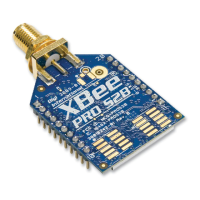XBee ZigBee networks ZigBee application layers: in depth
XBee/XBee-PRO ZigBee RF Modules User Guide 36
PAN ID
ZigBee networks are called personal area networks or PANs. Each network is defined with a unique PAN identifier
(PAN ID). This identifier is common among all devices of the same network. ZigBee devices are either
preconfigured with a PAN ID to join, or they can discovery nearby networks and select a PAN ID to join.
ZigBee supports both a 64-bit and a 16-bit PAN ID. Both PAN IDs are used to uniquely identify a network. Devices
on the same ZigBee network must share the same 64-bit and 16-bit PAN IDs. If multiple ZigBee networks are
operating within range of each other, each should have unique PAN IDs.
The 16-bit PAN ID is used as a MAC layer addressing field in all RF data transmissions between devices in a
network. However, due to the limited addressing space of the 16-bit PAN ID (65,535 possibilities), there is a
possibility that multiple ZigBee networks (within range of each other) could use the same 16-bit PAN ID. To
resolve potential 16-bit PAN ID conflicts, the ZigBee Alliance created a 64-bit PAN ID.
The 64-bit PAN ID (also called the extended PAN ID), is intended to be a unique, non-duplicated value. When a
coordinator starts a network, it can either start a network on a preconfigured 64-bit PAN ID, or it can select a
random 64-bit PAN ID. The 64-bit PAN ID is used during joining; if a device has a preconfigured 64-bit PAN ID, it
will only join a network with the same 64-bit PAN ID. Otherwise, a device could join any detected PAN and inherit
the PAN ID from the network when it joins. The 64-bit PAN ID is included in all ZigBee beacons and is used in 16-
bit PAN ID conflict resolution.
Routers and end devices are typically configured to join a network with any 16-bit PAN ID as long as the 64-bit
PAN ID is valid. Coordinators typically select a random 16-bit PAN ID for their network.
Since the 16-bit PAN ID only allows up to 65,535 unique values, and since the 16-bit PAN ID is randomly selected,
provisions exist in ZigBee to detect if two networks (with different 64-bit PAN IDs) are operating on the same 16-
bit PAN ID. If such a conflict is detected, the ZigBee stack can perform PAN ID conflict resolution to change the 16-
bit PAN ID of the network in order to resolve the conflict. See the ZigBee specification for details.
To summarize, ZigBee routers and end devices should be configured with the 64-bit PAN ID of the network they
want to join. They typically acquire the 16-bit PAN ID when they join a network.
Operating channel
ZigBee uses direct-sequence spread spectrum modulation and operates on a fixed channel. The 802.15.4 PHY
defines 16 operating channels in the 2.4 GHz frequency band. XBee modules support all 16 channels and XBee-
PRO modules support 14 of the 16 channels.
ZigBee application layers: in depth
This section provides a more in-depth look at the ZigBee application stack layers (APS, ZDO) including a
discussion on ZigBee endpoints, clusters, and profiles. Much of the material in this section can introduce
unnecessary details of the ZigBee stack that are not required in many cases.
Skip this section if:
The XBee does not need to interoperate or talk to non-Digi ZigBee devices
The XBee simply needs to send data between devices
Read this section if:
The XBee may talk to non-Digi ZigBee devices
The XBee requires network management and discovery capabilities of the ZDO layer
The XBee needs to operate in a public application profile (smart energy, home automation, and so forth).

